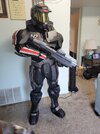Sorry its not a magical answer where just one thing makes it all better - but mostly that's solved by proper sizing/scaling.
Of course bad model design plays a factor. "Game accurate" is often not "real world wearable" and something I have to walk clients through often when it comes to making their armor. Its fairly common for first-time armorers to lean in to covering every cm² of their body rather than leave the joints open so they can bend the knee and elbow etc. Real life isn't a game where armor parts can magically fold into each other.
People new to printing armor often aren't experienced at scaling and distorting armor to match their body. That's why I continually suggest starting with a less technical armor that has looser tolerances. And work towards tighter fitting armor as you gain skill.
So I tend to post this response to the common or Frequently asked questions when people ask on the various social media channels. I copy/paste it to Facebook, or the Discord server and some folks urged me to post it here and just link it in the future. Ok, here goes. These are my tips and how...

www.405th.com
On a personal note: I've always looked at the MK-IV and thought:
If you are scaling uniformly that will be a big part of the problem. If you aren't using an accurate avatar and software to make your fitting match your body that's another big factor. (IE: Are you using Armorsmith?)
And you have to strap in a way that parts don't slide down. If the thigh is high for the first hour, then as you sweat and walk it slides down, its going to lock up the knee
View attachment 367891
In generally I'd suggest defining "mobility issues" as a bullet-point list and attack each issue individually.
- Elbow won't go straight
- Knee won't let me walk up/down stairs
- Waist doesn't let me sit




